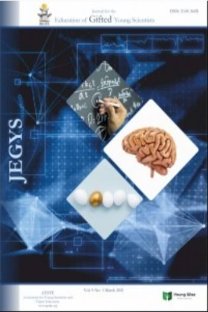Exploring the teacher-learner ratio and its effect on invitational teaching and learning: A South African study
Exploring the teacher-learner ratio and its effect on invitational teaching and learning: A South African study
teacher-learner ratio, class-size, overcrowding, invitational teaching and learning Invitational Theory,
___
- Africa Check. (2018). Women teach and men lead? Gender inequality in South African schools was examined. https://africacheck.org/fact-checks/reports/women-teach-and-men-lead-gender-inequality-south-african-schools-examined
- Ballantine J H (1983). The sociology of education. New Jersey: Prentice Hall.
- Creswell, J.W. (2014). Research Design: Qualitative, Quantitative and Mixed Methods Approaches (4th ed.). California: Sage.
- Dhal, P.K. (2021). Women and Teaching Profession. Conference paper presented in the National Seminar at THIS, Patna on 14 Feb 2016.
- Du Plessis, P. & Mestry, R. (2019). Teachers for rural schools - a challenge for South Africa. South African Journal of Education, 39(1). Online version ISSN 2076-3433. http://dx.doi.org/10.15700/saje.v39ns1a1774
- Ecole Admin. (2021). Importance of Discipline in Students' life. June 20, 2021. https://www.ecoleglobale.com/blog/importance-of-discipline-in-students-life/
- Egley, R., (2003). Invitational leadership. Does it make a difference? Journal of Invitational Education, 9:57-70.
- Haigh, M. (2011). Invitational Education: Theory, Research and Practice. Journal of Geography in Higher Education, (1):299-309.
- Hartshorne K (1992). Crisis and challenge: Black Education 1910-1990. Cape Town: Oxford University Press.
- Hun School of Princeton. (2019) Everything you need to know about student-teacher ratios. https://www.hunschool.org/resources/student-teacher-ratios
- Ismail, N.A.H. & Tekke.M. (2015). Rediscovering Rogers's Self Theory and Personality. Journal of Educational Health and Community Psychology, 4(3):2088-3129
- Johnson, W.L. (2014). Strategies for Improving School Performance. Conference Presentation. 2014 Curriculum Conference, June 11-12, 2014. Region VII Education Service Centre. Longview.
- Koc, N. & Celik, B. (2015). The Impact of Number of Students per Teacher on Student Achievement. Procedia - Social and Behavioral Sciences, 177: 65-70. doi:10.1016/j.sbspro.2015.02.335
- Kohler, T. (2020). Socioeconomic Status and Class Size in South African Secondary Schools. Stellenbosch Economic Working Paper: WP01/2020. Department of Economics. University of Stellenbosch. South Africa.
- Le Roux J (ed) (1993). The black child in crisis. A socio-educational perspective. Pretoria: JL van Schaik.
- Loeng, S. (2020) "Self-Directed Learning: A Core Concept in Adult Education," Education Research International, vol. 2020, Article ID 3816132, 12 pages, 2020. https://doi.org/10.1155/2020/3816132
- Maree, J.G. (Ed.). (2020). First Steps of Research. Pretoria: Van Schaik Publishers.
- Matthews, P.G. & Ellis, A.B. (2019). Natural Alternatives to Natural Number: The Case of Ratio. Journal of Num Cognition. 4(1), 19-58. doi: 10.5964/jnc.v4i1.97
- Meador, D. (2019). Solutions for teaching in an overcrowded classroom. ThoughtCo. https://www.thoughtco.com/teaching-in-an-overcrowded-classroom-3194352
- Phitidis, K. (2022). An aspiration to retain young teachers as a national teacher network is launched. Daily Maverick. https://www.dailymaverick.co.za/article/2022-10-14-an-aspiration-to-retain-young-teachers-as-national-teacher-network-is-launched/
- Purkey W W (1987). What is an invitational theory, and how does it relate to practice? Greensboro: University of North Carolina.
- Purkey, W. (1991). What is invitational education and how does it work? Oxford: Oxford University Press.
- Purkey, W. & Aspy, D. (2003). Overcoming tough challenges: An invitational theory of practice for humanistic psychology. Journal of Humanistic Psychology, 43:146-155.
- Purkey, W. & Novak, J. (2015). An introduction to invitational theory. Journal of Invitational Theory and Practice, (1):1-7.
- Purkey, W. (1992). An introduction to invitational theory. Journal of Invitation Theory and Practice, 1(1):5-14.
- Singh, P. & Mahomed, C.C. (2013). The Value of Mentoring To Develop Student Teachers' Work-Integrated Learning Skills. International Business & Economic Research Journal, 12(11): 1373-1388
- Smart, L. (2019). Teacher experiences in creating an invitational learning environment in a diverse classroom. Master dissertation. Unpublished dissertation. The University of Pretoria. Pretoria.
- Smith, K. & Hunter, M (2007). Inviting school success: Invitational Education and the Art Class. Journal of Invitational Theory and Practice, (13):8-15.
- Tani, M. (2019). Why are teachers mostly female? SBA News. https://www.sbs.com.au/news/insight/article/why-are-teachers-mostly-female/lh5hu1tfg
- Thakur, S. (2021). Is teaching the most lucrative career? Are teachers getting paid well ?https://www.linkedin.com/pulse/teaching-most-lucrative-career-teachers-getting-paid-well-shiv-thakur
- Van de Walle, J.A., & Lovin, L.A.H. (2006). Teaching student- centered mathematics: Grades K-2. Boston: Pearson.
- Venketsamy, T. (2000). The educator-learner-ratio and its effects on invitational learning. Unpublished Doctoral thesis. Durban: University of Zululand.
- Venketsamy, R., Smart, L and Sing, N. (2020). Teachers’ perceptions in creating an invitational learning environment in culturally diverse foundation phase classroom. Perspectives in Education Journal. 38(2): 118-137. https://doi.org/10.18820/2519593X/pie.v38.i2.08
- West, J & Meier, C. (2020). Overcrowded classrooms - The Achilles heel of South African education. South African Journal of Childhood Education, 10(1): 1-10
- Wokoma, I.P. (2020). Learning and problem-solving: Using problem-solving methods to achieve learning in pupils. African Social and Educational Journal, 9(3): 239-250.
- Wright, MC., Bergom, I. & Bartholomew, T. (2017). Decreased class size, increased active learning? Intended and enacted teaching strategies in smaller classes. Active Learning in Higher Education, 20(1): 51-62. https://doi.org/10.1177/1469787417735607
- Zenda, R. (2019. Impact of the learner-educator ratio policy on learner academic achievement in rural secondary schools: A South African case study. African Education Review, 3. 37-51. https://doi.org/10.1080/18146627.2019.1588748
- Başlangıç: 2013
- Yayıncı: Genç Bilge Yayıncılık
Examining the views of trainers and trainees on the effectiveness of on-line Youtube guitar training
Bibliometric analysis of graduate theses on music culture in Türkiye
Investigation of body posture problems experienced in baglama teaching process
Ayşe Nur KATMER, Zeynep HAMAMCI
